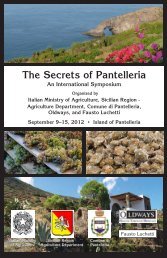Turkey's Culinary Heritage - Oldways
Turkey's Culinary Heritage - Oldways
Turkey's Culinary Heritage - Oldways
You also want an ePaper? Increase the reach of your titles
YUMPU automatically turns print PDFs into web optimized ePapers that Google loves.
An Essential Turkish Pantry<br />
Mastic: resin from a tree that grows on the island of Chios. It is also a plant<br />
resin taken from a Mediterranean shrub.<br />
Sumac: crimson colored berry that is ground. Tart and slightly sour flavor<br />
like lemon.<br />
Pomegranate molasses: a thick, tart syurp<br />
that is used in salads and cooking made<br />
from pomegranate juice. Delicious with<br />
lamb stews or any lamb preparation. I recommend<br />
bringing some back because the<br />
commercial varieties available in the US are<br />
not nearly the quality that we will find in the<br />
markets in Turkey.<br />
Tahini: sesame paste made from sesame<br />
seeds. In Turkey, they like to double roast<br />
the sesame seeds.<br />
Sahleb: orchid root from wild orchids with sweet flavor. Used to flavor ice<br />
cream and to thicken a warm milk drink.<br />
Dried Spearmint: sweet, warm flavor. Try using spearmint in place of<br />
oregano in your favorite tomato sauce<br />
Maraş pepper: rich, oily, sweet, caramelized flavor with mild heat from<br />
Maraş.<br />
Red pepper paste: artisinally, this is made like tomato paste where sweet<br />
and hot peppers are dried in the sun to concentrate the flavors into a paste.<br />
Use in place of tomato paste in vegetable or meat preparations.<br />
Baharat: this literally means spice. A<br />
loose word for spice blend. Baharat’s can<br />
vary by the region, recipe, person, etc. A<br />
cook mixes a baharat as they are cooking.<br />
For instance, if it’s a hot day and<br />
they are making grilled lamb the baharat<br />
would be blended one way. If it was a cold<br />
day and they were braising lamb the baharat<br />
would be made another. The range<br />
can be from 7 to 15 different spices.<br />
Nigella seeds: have a slightly bitter taste like celery seed. You see these<br />
seeds all over the breads, crackers and in string cheese. They are not the<br />
same as black sesame seeds which they often get confused for.<br />
Ana Sortun<br />
Traditional Turkish Dishes<br />
Biber dolması: stuffed pepper<br />
Börek: pastry that is filled with cheese and<br />
vegetables or meat<br />
Dolma: vegetables stuffed with rice or spiced<br />
meat and then cooked in olive oil<br />
Dondurma: Turkish ice cream, but with a<br />
much thicker, stickier texture than the Western<br />
variety. Distinctive, and definitely worth trying!<br />
Gözleme: flat bread that is stuffed with spinach,<br />
feta, or meat.<br />
Kebab: (or kebap) simply means “roasted,”<br />
and usually refers to lamb roasted in some<br />
form, but may refer to chicken—or even<br />
(roasted) chestnuts—as well. The most familiar<br />
Turkish kebap is shish kebap: chunks of lamb roasted on a skewer.<br />
Köfte: a bulgur-based pate or dough. It is used to make small, round meatballs—often<br />
lamb or mutton—mixed with onions, spices, and crumbled<br />
bread.<br />
Künefe: a dessert made with shredded phyllo dough (called kadafi). The<br />
dough is filled with sweet cheese, baked, and then soaked in a sweet syrup.<br />
Manti: tiny, meat-filled pasta often topped with garlic yogurt and a spicy<br />
tomato sauce.<br />
Pilaf: Generally made of rice, but also of bulgur and sehriye (vermicelli). A<br />
staple of the Turkish table, pilaf may include eggplant, chick peas, beans,<br />
or peas.<br />
Simit: ring-shaped snack bread that is often covered with sesame seeds.<br />
Yaprak sarma: Vine leaves stuffed with rice, herbs, and pine nuts.<br />
Raki<br />
20 21<br />
Raki is a clear brandy flavored with pungent anise.<br />
Most is quite potent (80 to 90 proof/40% to 45% alcohol)<br />
and thus diluted with water and sipped. It is similar<br />
to Green ouzo and French pastis. vWhen mixed with ice<br />
and/or water for drinking, it turns milky white. Because<br />
of its color and hefty alcoholic punch, Turks call it lion’s<br />
milk (aslan sütü).<br />
How to drink raki:<br />
Fill a clear, straight, narrow glass 1/3 or 1/2 full with raki,<br />
then dilute with water and/or ice to taste.




